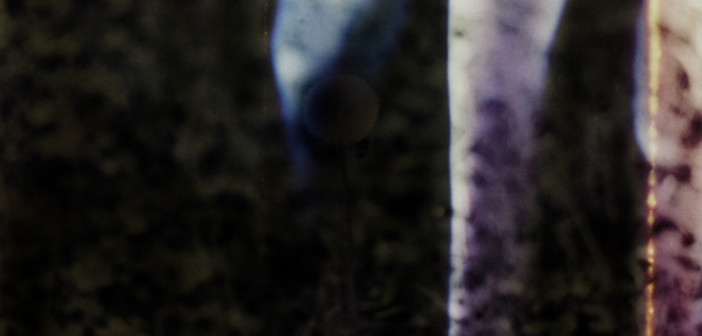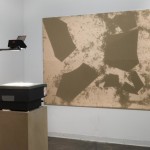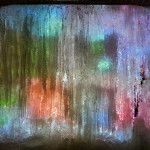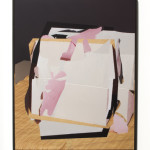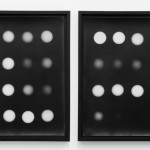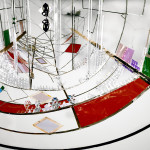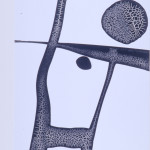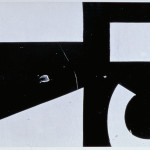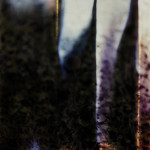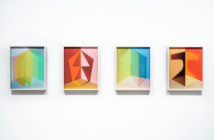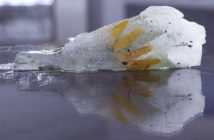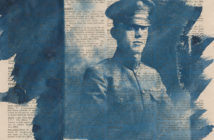Second nature: abstract photography then and now is a lot more "now" than "then." Loud, crowded and eye-pleasing, the show has a lot to look at, but doesn’t immediately beg an intensive viewing. Hung salon-style in a smallish second floor gallery of the deCordova, second nature feels more than anything like it could use more space. The multiple-layer hanging screams of necessity rather than intention, and odd pairings and arrangements of works only further confuse any kind of narrative reading. However, the curator emphasizes that this is not a survey, rather "a focused study of art being made today that revisits and continues some of the themes and creative studies of early 20th-century photography."
Historical works are mixed in with the contemporary, and oftentimes it’s hard to tell which is which. Unlike a major historical photography show like Faking It: Manipulated Photography Before Photoshop, on view at the Metropolitan, historical elements aren’t heavily represented, and what’s there is understated and focused less on specific technical or creative leaps than the practice of a handful of photographers who were working within the New Bauhaus and abstract expressionist generation. Most prominent among these is Aaron Siskind, whose abstractions from everyday life promoted not just an artistic style but a way of looking at the world. His work and his legacy crop up throughout.
At the center of the show stands the idea that contemporary abstract photographic practice is a "return to form" and to the ideas found in historical experiments in photography. There is indeed a break in the exhibition’s timeline between 1987, the latest "historical" work (a set of prints from Siskinds late series The Road), and the mid— to late—2000s, when most of the contemporary work was made. For much of the history of photography, technological progress spurred the medium forward to new techniques and aesthetic possibilities. But it seems that some time in the last ten years we hit a wall, and artists started looking back at lost trails of inquiry, particularly at the potential of analog photographic abstraction.
The most successful works on view continue Siskind’s tradition of using the implicit literal qualities of photography, that is, the photographic image as a literal representation of something in the world, and inverting this to create something that is not immediately recognizable. Siskind finds abstraction everywhere, and while his images are tightly cropped and removed from context, he still gives us enough to know we are looking at a wall or a crack in the sidewalk. This differs from the studio assemblages of György Kepes, the show’s other prominent historical figure, who treated light as his raw material, not the world around him. More control, less of the incidental and recognizable.
The contemporary works in this show swing between these poles. Much of the work produced is "studio abstraction," wherein the artist, like Kepes, is setting up conditions within the studio to produce the abstract equivalent of still-lifes. This is a phenomenon that has exploded within the past five to ten years among younger artists. One explanation for the tendency could be the embracing of photography as an interdisciplinary tool, one used by artists who could describe themselves just as readily as sculptors, painters, installation artists—people with access to studios and a familiarity with plastic materials, not simply using darkrooms and cameras.
On the other hand, the darkroom is also becoming a site for total experimentation, as photographers searching for accuracy or clarity turn instead to digital tools. Outmoded technology becomes romantic to our culture, and irresistible to our artists. We see this with the proliferation of slide projectors, typewriters, card catalogues and film projectors in new work. Arguably, as the darkroom and its tools fall into obsolescence, so do their particular qualities become the stuff of a new, romantic abstraction.
Josh Brand is a clear example (though sadly not on view in second nature)—he makes unique prints, often photograms, by physically manipulating materials between the enlarger and the paper in the darkroom. Some prints are treated with ink after the fact, adding to their singular qualities. RH Quaytman, who identifies as a painter but works predominantly with photo-based screen prints treated with various optical effects, justified her move away from pure photography in the introduction to her catalogue, Spine. She describes the photographic print as a sad, delicate, drooping thing, and sought a means to create photographic images with more physical, and perhaps psychological, integrity. In opposition, Brand embraces this weakness. The photographic paper is an object, albeit an unstable, half-present object. In Brand’s work, the image on the paper’s flimsy surface was arrived at somewhat unpredictably through a series of tentative arrangements made by the artist. As a process it’s akin to the sort of inward-looking yet half-serious, half-finished method of painting described in Raphael Rubinstein’s recent, significant set of essays and subsequent exhibition at Modern Art, Provisional Painting. This sort of provisional photography is a way out from the increasing demand for "perfect" digital images, as camera technology grows more advanced and more easily available. Aspen Mays, whose prints from the series The Sun 1957 greet visitors at the entrance to the gallery, has a similar approach to his prints, a lack of preciousness that is refreshing.
While the analog image is seen throughout the show, there is at least one strong example of digitally manipulated work—Lucas Blalock’s Scenario for Barter. We see what is likely an unremarkable sculptural object of rough-cut Styrofoam, painted pink on one side, sitting on a bedspread. However, multiple layers from different angles are blended together in Photoshop, roughly in places, imperceptibly in others. The artist is using tools many of us would be familiar with, duplicating and blending to create an image that is mundane and recognizable yet totally jarring. We’ve become extremely discerning of digital images, particularly doctored images, and it takes real ability to make something that is actually disarming. This is evidenced by the other digital abstractions on view, which are just lackluster. Julia Hechtman’s video Sunhead shows a lens flare above the artist’s head, and doesn’t do much else for four minutes. More complex but similarly disappointing is Daniel Philips’ Ice Cave, a colorful abstract video projected onto melting ice. There is something about video projection and textured surfaces that just doesn’t quite work. It’s like pairing a photograph with sound—the brain won’t have it.
Some other highlights include Bryan Graf’s beautiful, understated Wildlife Analysis series, which points to the visual for what it is: the product of radiation. Muted images of wild grasses are bled with flares of red and purple light that edge along dark masses intruding over the image. Color, usually a clarifying element in photography, becomes something menacing, akin to a kind of pollution within the frame.
Daniel Lefcourt’s Passive Surplus is an overhead projector sitting on an unpainted, custom-built pedestal. Wood shavings and sawdust likely left over from its construction sit on the projector bed, and their shadows are thrown against the wall in a rough abstraction that beckons to the Siskind compositions around the room. Visual markers of process are present in much of the show, but it’s satisfying to see such a completely physical example in a room full of prints.
In realistic painting, i.e. paintings of things, there is a sustained illusion that we are looking through a window into a semblance of reality. Abstract painting arguably denies this illusion, tells us, that no, we are in fact looking at paint, observing its properties and how they interact. (This of course has been expanded on since the mid-twentieth-century, but I’m reducing for the sake of argument.) It’s more complicated issue for photography. A realistic photograph is also an illusory window, like a realist painting, but an abstract photograph cannot simply be a sum of its properties like an abstract painting. It must also be a picture of something, however ephemeral, decontextualized or otherwise disguised. The various ways in which the artists in this show demonstrate the double-life of the abstract photographic image is what keeps the show buoyant and active. You aren’t likely to learn much, unless you pay careful attention to clues of how certain images are made. Instead, the real pleasure comes from the cerebral flipping back and forth from abstract picture to photographic image to be found in each work. The eye and the mind buzz with this kind of activity.
- Daniel Lefcourt, Passive Surplus, 2011, sawdust, plaster, mdf, overhead projector. Courtesy of the artist and Mitchell-Innes & Nash, New York, NY.
- Daniel Phillips, Ice Cave, 2012, video projection onto ice. Courtesy of the artist and Dodge Gallery, New York, NY.
- Lucas Blalock, Scenario for Barter, 2011, c-print. Courtesy of the artist and Ramikan Crucible, New York, NY.
- Aspen Mays, October and December, from the series The Sun 1957, 2010, four silver gelatin prints. Courtesy of the artist and golden Gallery, New York, NY.
- Yamina Nayar, By a Thread, 2009, c-print. Courtesy of the artist and Thomas Erben Gallery, New York, NY.
- György Kepes, Untitled, 1940, silver gelatin print. Gift of Arlette and Gus Kayafas.
- Aaron Siskind, Chicago 16, 1957, silver gelatin print. Gift of Pete and Constance Kayafas.
- Bryan Graf, Dandelion from Wildlife Analysis, 2008—12, analog c-print. Courtesy of the artist and Yancey Richardson Gallery, New York, NY.
Second nature: abstract photography then and now is on view now through March 3, 2013 at the deCordova Sculpture Park and Museum.

